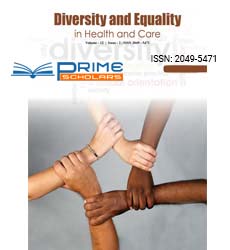Commentary - (2024) Volume 21, Issue 6
Overcoming Language Barriers in Healthcare: A Key to Better Patient Outcomes
Wei Chen*
Department of Sciences, Tsinghua University, China
*Correspondence:
Wei Chen,
Department of Sciences, Tsinghua University,
China,
Email:
Received: 02-Dec-2024, Manuscript No. IPDEHC-25-22098;
Editor assigned: 04-Dec-2024, Pre QC No. IPDEHC-25-22098 (PQ);
Reviewed: 18-Dec-2024, QC No. IPDEHC-25-22098;
Revised: 23-Dec-2024, Manuscript No. IPDEHC-25-22098 (R);
Published:
30-Dec-2024, DOI: 10.35248/2049-5471-21.6.55
Description
Language barriers in healthcare are a significant challenge
that can affect the quality of care patients receive, leading
to miscommunication, misunderstandings, and poor health
outcomes. As the global population becomes increasingly
diverse, healthcare providers are facing the complex task of
offering services to patients who speak different languages.
Whether due to immigration, traveling, or living in multicultural
societies, many patients find themselves struggling to
communicate with healthcare providers, which can lead to
critical errors in diagnosis, treatment, and follow-up care.
Addressing language barriers in healthcare is not only a moral
and ethical imperative but also crucial for improving patient
outcomes and promoting health equity. Language barriers in
healthcare can lead to a host of challenges that affect both
patients and healthcare providers. Misunderstanding medical
instructions is one of the most common and dangerous
consequences. Patients who do not understand their doctorâ??s
instructions or prescriptions may take medications incorrectly
or fail to follow treatment plans, leading to complications. For
example, a patient who does not understand how to take a
prescribed medication might take too much or too little, which
can result in adverse effects. Moreover, miscommunication
can result in incorrect diagnoses. If a patient cannot fully
explain their symptoms or medical history because of language
limitations, the healthcare provider may misinterpret the
information, leading to misdiagnosis or delayed treatment. In
some cases, important details about a patientâ??s condition may
be missed, resulting in the progression of illness or unnecessary
procedures. Additionally, language barriers can create a sense
of mistrust between patients and healthcare providers. If
patients feel they are not being understood or are not able to
communicate effectively, they may feel uncomfortable seeking
care or may avoid healthcare services altogether. This lack of
trust can be particularly problematic in emergency situations
when patients may be reluctant to share vital information due
to language difficulties. In many parts of the world, healthcare
systems serve a population that speaks multiple languages.
In the United States, for example, nearly 1 in 5 people speaks
a language other than English at home. In other countries,
there are significant populations of immigrants, refugees,
and temporary residents who speak a variety of languages.
This makes it essential for healthcare systems to address
language diversity and ensure that patients can access the
care they need in their preferred language. To meet this need,
healthcare organizations must offer multilingual services,
including interpretation and translation services, to help
facilitate communication between patients and providers.
This can include in-person interpreters, telephone or video
interpretation services, or digital translation tools. While some
healthcare providers are more equipped to handle language
diversity, many face challenges in providing these services
consistently and effectively. In some areas, there may not be
enough qualified interpreters available, or the cost of providing
interpretation services may be a barrier for certain healthcare
institutions. There are several strategies that healthcare
providers can adopt to reduce language barriers and improve
patient outcomes. One of the most effective solutions is the
use of professional interpreters. Professional interpreters are
trained to bridge the communication gap between patients
and healthcare providers, ensuring that important medical
information is accurately conveyed. Whether in-person or via
phone or video, interpreters play a crucial role in improving
patient understanding and promoting clear communication.
Acknowledgement
None.
Conflict Of Interest
The author's declared that they have no conflict of interest.
Citation: Chen W (2024) Overcoming Language Barriers in Healthcare: A Key to Better Patient Outcomes. Divers Equal Health Care. 21:55.
Copyright: © 2024 Chen W. This is an open-access article distributed under the terms of the Creative Commons Attribution License, which permits unrestricted use, distribution, and reproduction in any medium, provided the original author and source are credited.

